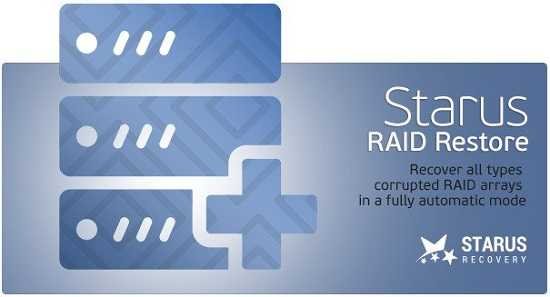Portable Starus RAID Restore 2.0 Multilingual

This program recovers data from non-operational RAID systems or from disks within such systems. It reads all the information about the controller, the motherboard or the software used to create a disk array. Our product can rebuild the crashed RAID and it lets you copy all critical information from there.
The integrated constructor wizard helps you recover a failing RAID in a step-by-step mode. You can use one of the presets or chose the required data in the damaged array, and RAID Recovery™ will collect the disks together to provide you with access to the data.
This program can recover data from non-operational RAID systems or disks within such systems. It reads all information about the controller, the motherboard, or the software used to create a disk array. It can rebuild the crashed RAID and lets you copy all critical information from there.
It helps you to recover a failing RAID in a step-by-step mode. Use one of the presets or choose the required data in a damaged array, and it can collect the disks together to provides you with access to the data.
Why RAID gets damaged
Recover software or hardware RAID of any type: JBOD, RAID 0, RAID 1, RAID 10, RAID 5, RAID 50, RAID 6, RAID 60, etc.
Hard disk failure
Both hard disk types, HDD and SSD, have a limited operational life. Certainly, server-type NAS or SCSI disks can last longer than their SATA counterparts intended for home use only, but there is no such thing as a hard disk that works endlessly. For most RAID arrays, the day when one or two disks fail means loss of all information, from all disks within this array. Reliability of the entire array decreases with every disk which is added to it.
Accidental array rebuilding
Mistakes when replacing one of the disks within the storage system, accidental “rebuilding” of the array instead of “restoring” it, disconnecting and reconnecting the disks in a wrong order, incorrect RAID initialization or rebuild – any of these things will certainly result in the loss of information. After such errors, RAID can’t restore itself automatically.
A controller bug or failure
A controller is the element containing information of critical importance which is vital for building a disk array and gaining access to all of the files stored on the disks. A controller failure may both result in losing service data and cause several disks to fail. The most expensive controllers use an additional battery and non-volatile memory. Such elements improve the whole system’s reliability and are supposed to help save data even if a power interruption occurs.
A motherboard failure
Creating a RAID based on specific motherboard features is a cheaper (though less reliable) solution in comparison with buying an expensive controller. Motherboard failures, botched BIOS updates, low CMOS battery, power surges, disconnecting or reconnecting disks – all these things may cause your RAID to crash. As the entire system is very sensitive to all kinds of power issues, problems with your power supply unit may cause crashes as well.
A system crash
Software RAID systems based on the functionality offered by an operating system – Windows, macOS, Linux, FreeBSD, Ubuntu – depend largely on the health of that operating system. Upgrading your hardware, or updating other software may cause errors that prevent the computer from booting and make the data inside such array inaccessible.
Unlike hardware RAID systems, the software-based arrays are made of logical partitions rather than physical disks. Operations that involve formatting or removing partitions can easily destroy such array.
Features of Starus RAID Restore
- Recover software and hardware RAID
- Manual and automated recovery options
- Recovers files from corrupted RAID
- Windows restrictions are bypassed by the recovery process
- Recovers Data from Lost Partition
- Recovery from Storage Drive that has Bad Sectors
